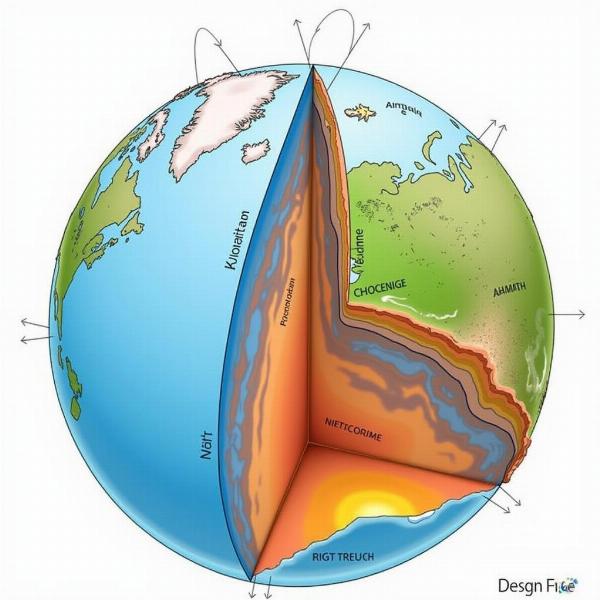Endogenic forces, meaning in Hindi “आंतरिक बल” (āntarik bal), are powerful forces originating from within the Earth. These forces play a crucial role in shaping the Earth’s surface, creating mountains, valleys, and other geological features. Understanding endogenic forces is key to comprehending the dynamic nature of our planet and the processes that have molded it over millions of years.
Understanding Endogenic Forces and Their Impact
Endogenic forces are driven by the Earth’s internal heat and radioactive decay. This energy manifests in various forms, including tectonic plate movements, volcanic eruptions, and earthquakes. These processes can have both constructive and destructive effects on the Earth’s surface. For example, while volcanic eruptions can devastate surrounding areas, they also contribute to the formation of new landmasses. Similarly, tectonic plate movement can cause earthquakes but also leads to the creation of mountain ranges like the Himalayas.
What causes these forces to act in the first place? The Earth’s internal heat is the primary driver. This heat, generated from the planet’s formation and the decay of radioactive elements, creates convection currents within the mantle, causing the tectonic plates to move. These movements are responsible for many of the Earth’s most dramatic geological features.
Types of Endogenic Forces
Endogenic forces are categorized into two main types: diastrophism and volcanism. Diastrophism involves the deformation of the Earth’s crust, leading to the formation of folds, faults, and other structural features. Volcanism, on the other hand, is characterized by the eruption of molten rock (magma) onto the Earth’s surface.
Diastrophism: Shaping the Earth’s Crust
Diastrophism plays a crucial role in shaping continents, oceans, and mountain ranges. It encompasses processes like folding, faulting, and warping, which alter the Earth’s surface over long periods. The Himalayas, for example, are a result of the collision of the Indian and Eurasian tectonic plates, a diastrophic process.
Volcanism: The Earth’s Fiery Breath
Volcanism, the eruption of magma from the Earth’s interior, is a dramatic display of endogenic forces. Volcanoes can be both destructive and constructive, destroying existing landscapes while simultaneously creating new landforms. The Hawaiian Islands, for instance, are a product of volcanic activity.
How Endogenic Forces Shape the Earth’s Surface
Endogenic forces are constantly reshaping the Earth’s surface. The movement of tectonic plates creates mountain ranges, rift valleys, and ocean basins. Volcanic eruptions form volcanic mountains, plateaus, and islands. Earthquakes, though destructive, are also a manifestation of these powerful forces.
 Tectonic Plate Movement
Tectonic Plate Movement
Dr. Anika Sharma, a renowned geologist from the Indian Institute of Science, Bangalore, explains, “Endogenic forces are the architects of our planet’s landscape. They are the reason why we have mountains, valleys, and oceans. Understanding these forces is essential for comprehending the Earth’s dynamic nature.”
Conclusion: The Continuing Influence of Endogenic Forces
Endogenic forces, or “आंतरिक बल” (āntarik bal), are fundamental to understanding the Earth’s evolution. These powerful forces, originating from within the Earth, continually reshape our planet’s surface, creating a dynamic and ever-changing landscape. From the majestic Himalayas to the fiery volcanoes of Hawaii, the impact of endogenic forces is visible all around us.
FAQs:
- What is the main difference between endogenic and exogenic forces? Endogenic forces originate from within the Earth, while exogenic forces act on the Earth’s surface from the outside.
- What are some examples of endogenic forces? Examples include earthquakes, volcanic eruptions, and tectonic plate movement.
- How do endogenic forces contribute to mountain building? Tectonic plate collisions, a type of endogenic force, are a primary driver of mountain building.
- What is the role of internal heat in endogenic forces? Internal heat drives convection currents in the mantle, causing tectonic plates to move and leading to various endogenic processes.
- Are endogenic forces always destructive? No, while they can be destructive (like earthquakes), they are also constructive, forming new landmasses and geological features.
- What is the Hindi meaning of ‘endogenic forces’? It is “आंतरिक बल” (āntarik bal).
- Where can I learn more about exogenic forces? You can check out our article on exogenic forces meaning in hindi.
Meaning-Hindi.in offers expert translation services in Hindi and other languages, specializing in business, legal, technical, website, educational, and specialized translations. We provide accurate and culturally sensitive translations for a wide range of documents. Need help with your translation project? Contact us today! Email: [email protected], Phone: +91 11-4502-7584. Meaning-Hindi.in is your trusted partner for all your translation needs.